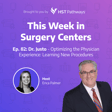
Alex Yampolsky – Stopping Drug Diversion at Your ASC
Alex Yampolsky is the CEO of MedServe, and he will join us this week to share insights into how you can stop drug diversion at your ASC. Drug diversion is not a topic we’ve covered yet, and I think the work Alex and his team are doing is super important. I’m excited for everyone to hear our conversation and hopefully implement some of Alex’s advice. We cover the most vulnerable areas in an ASC, tools that ASCs are using to help, some red flags to look for, and how to build a culture where staff feel comfortable addressing their concerns with leadership.
After my conversation with Alex, we’ll switch to our Data & Insights segment. Today, we’ll break down the average OR and Recovery Times per specialty. Every minute in the OR and Recovery Area counts, so while patient safety is the number one priority, it’s essential to look at the industry averages to see if you have the opportunity to increase efficiency.
Resources Mentioned:
HST’s State of the Industry Report
Aromatherapy's Role in Decreasing Postoperative Nausea and Vomiting
Brought to you by HST Pathways.



















